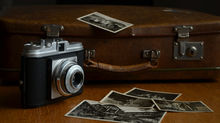How to Choose Between TIFF, 300dpi & 600dpi JPEG Files
- Stephen Stewart
- Nov 2, 2015
- 3 min read

Let’s talk about the differences between file formats JPEG and TIFF as well as some of the pros and cons for both. We’ll also touch on what DPI means and how it will help your pictures. You’ll find that your choice of format can be vitally important depending on your end goal for having your photos scanned.
What is TIFF?
TIFF is a more rare format in picture file type. However, we love TIFF because TIFF keeps the full resolution of your photo every time it is saved. This is typically chosen for your most cherished photos that will potentially be reprinted for displaying. You won’t lose quality in saving the photo as a TIFF format so you are always sure that the file will be in the best condition. The biggest drawback to saving the file as a TIFF is the size of the photo. Because you are not sacrificing quality for file size, the high resolution of a TIFF typically comes in a larger file.

What is JPEG?
Most people have heard of a JPEG or JPG as it is the most common picture file type on the web today. As such, almost any server or photo editing software is going to understand and accept the file for use. Another benefit to the JPEG format is that it typically requires less memory than most of the other formats. The reason is because a JPEG file is typically saved in a loose glossy format. That means that some of the quality of the image is lost because the software compresses the photo to make it a smaller size often costing some clarity, especially in printing. So you often sacrifice quality for file size when saving JPEG.
What is DPI?
At Scan My Pix, we offer 300 and 600 DPI to ensure the highest quality of picture printing. DPI stands for Dots Per Inch and is somewhat synonymous with PPI or Pixels Per Inch in the digital photo age. This is important to remember in the size and quality of the photo you want to print. If you want further clarity, especially with older photos, then increasing the DPI in your printing will help provide clearer imaging.
When to Choose JPEG vs TIFF
Deciding when to choose JPEG and when to choose TIFF ultimately depends on the picture itself and what purpose that the photo serves. Is your scanned picture extremely old, valuable, or already hard to view clearly? If so, choosing TIFF will keep this photo’s original appearance without sacrificing even the slightest bit of clarity during the scanning process. TIFF is especially useful for large family photos that will possibly be reprinted and distributed to family members as it will ensure that each print is just as clear and meaningful as the original. Is your main purpose of scanning to share digitally or simply preserve your photos? If so, then JPEG would be sufficient. Choosing 600dpi will allow decent prints while maintaining a manageable storage size as compared to TIFF. Photos scanned to 300dpi JPEG can also be reprinted in smaller sizes, but the clarity is not guaranteed to match the original. Choosing between JPEG and TIFF can be easy – simply save your most valuable photos in TIFF format while the majority will be safely preserved in a smaller JPEG file, giving you the best of both worlds.
If choosing between TIFF, 600dpi JPEG and 300dpi JPEG files is still difficult, don’t worry, call a photo scanning technician at Scan My Pix and we’ll guide you every step of the way to talk about what option will best fit your needs!



























Comments